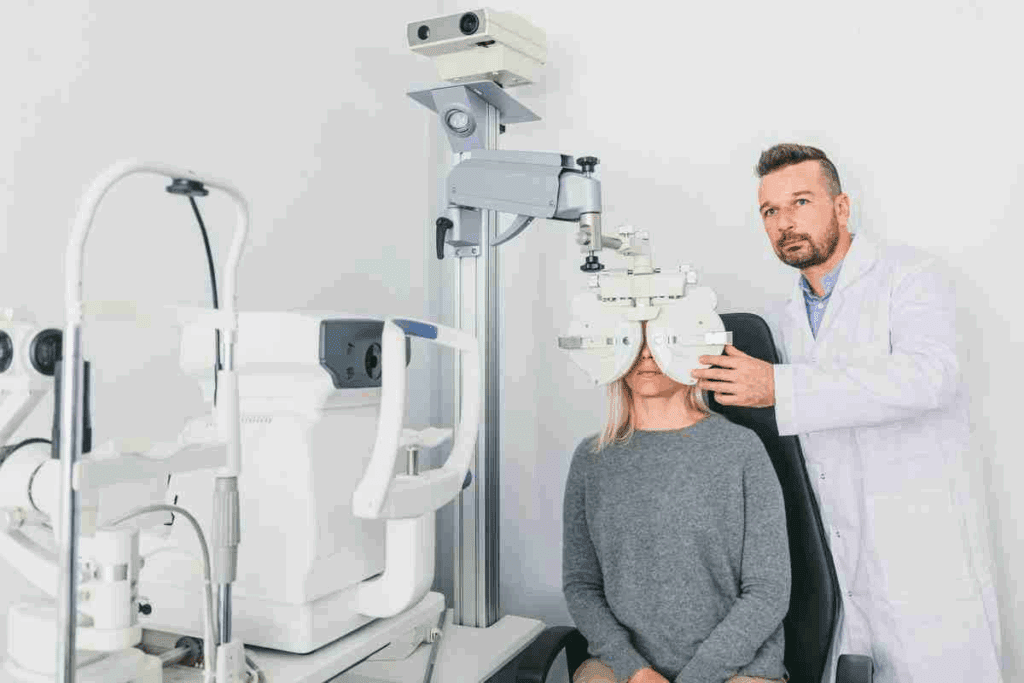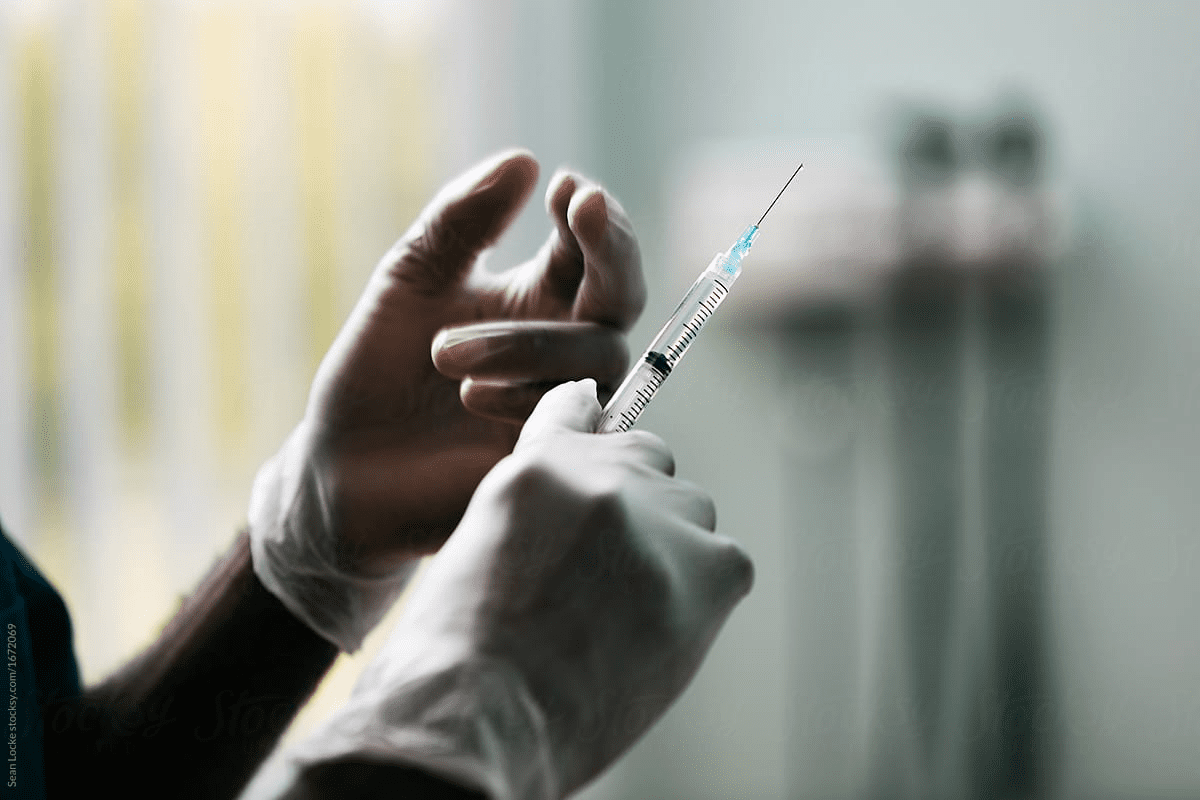Last Updated on November 26, 2025 by Bilal Hasdemir

At Liv Hospital, we lead in eye care with precise medical tools like the steroid shot needle. We use these tools for critical treatments of complex retinal diseases. Intravitreal drug delivery is now the top choice for treating diseases like neovascular age-related macular degeneration (AMD), diabetic retinopathy, and retinal vein occlusion.
We understand the need for effective treatment options for patients with macular edema and other retinal diseases. Our method involves giving essential eye injection medications directly into the eye. This ensures targeted and efficient care.
Key Takeaways
- Intravitreal injections are a key treatment for various retinal diseases.
- Steroid shot needles deliver medications directly into the eye.
- Treatments are available for conditions like AMD and diabetic retinopathy.
- Precision is key in administering intravitreal medications.
- Liv Hospital is a leader in innovative, patient-centered eye care.
Understanding Eye Injections for Retinal Diseases

Eye injections for retinal diseases are key in today’s eye care. They offer targeted treatments for many eye problems.
The Purpose of Intravitreal Injections
Intravitreal injections go right into the eye’s gel-like substance. Their main goal is to get medicine straight to the retina. This ensures the treatment works best where it’s needed most.
These injections use medicines like anti-VEGF agents and steroid implants. Anti-VEGF drugs, like Lucentis and Eylea, fight wet AMD by stopping bad blood vessels from growing.
How Medications Are Delivered to the Retina
Getting medicine to the retina is a precise process. It’s done by eye specialists in a clinical setting.
The eye is first numbed. Then, a fine needle injects the medicine into the vitreous. This method ensures the medicine reaches the retina effectively.
Common Conditions Requiring Eye Injections
Eye injections help with many eye diseases, like diabetic retinopathy and wet AMD. Diabetic retinopathy can cause blindness if not treated. Anti-VEGF injections can prevent vision loss and improve outcomes for diabetic retinopathy patients.
| Condition | Common Treatment | Benefit |
| Diabetic Retinopathy | Anti-VEGF injections | Reduces risk of vision loss |
| Macular Edema | Steroid implants | Reduces retinal swelling |
| Wet Age-related Macular Degeneration | Anti-VEGF injections | Inhibits the growth of abnormal blood vessels |
The Steroid Shot Needle: Precision Technology for Eye Treatment

The steroid shot needle is a big step forward in eye care. It lets doctors put medicine right into the eye. This is key to treating many eye diseases.
Anatomy of an Intravitreal Injection Needle
An intravitreal injection needle is made with great care. The needle’s gauge and length are chosen carefully to make it as painless as possible. A 30-gauge or 31-gauge needle is usually used. It’s the right size to be comfortable and strong.
Safety Features of Modern Eye Injection Tools
Today’s eye injection tools have many safety features. They have special hubs to prevent accidents and clear marks for accurate medicine placement. They also work with specific devices to make the process safer.
How Retina Specialists Administer Injections
Giving intravitreal injections is a complex task. Retina specialists get a lot of training for this. They prepare the eye, give the injection, and watch the patient afterward. Their goal is to make the patient as comfortable as possible and avoid problems.
Anti-VEGF Treatments: First-Line Therapy for Retinal Conditions
Anti-VEGF injections are now the first choice for many retinal problems. They help keep and improve vision. These treatments are safe and effective for conditions like macular edema and diabetic retinopathy.
They work well for wet age-related macular degeneration (AMD). About 1 in 3 people see their vision improve. And about 9 out of 10 people stop losing vision.
Lucentis (Ranibizumab): Applications and Efficacy
Lucentis, or Ranibizumab, targets VEGF in the retina. Clinical trials show it’s effective against wet AMD, diabetic macular edema, and retinal vein occlusion. Patients usually get monthly injections, which can change based on how they respond.
“Lucentis has changed the game for wet AMD,” says a top retina specialist. “It gives patients a chance to keep their vision and live better.”
Eylea (Aflibercept): Treatment Protocol and Results
Eylea, or Aflibercept, is known for its effectiveness and possibly longer action than Lucentis. It binds to VEGF to reduce its effects on the retina. Studies show Eylea improves vision in wet AMD and diabetic macular edema. It’s given every two months after the first month of daily doses.
- Effective in treating wet AMD and diabetic macular edema
- Potentially longer duration of action
- Bimonthly injections after an initial loading dose
Avastin (Bevacizumab): Cost-Effective Off-Label Option
Avastin, or Bevacizumab, is used off-label for retinal diseases. It’s cheaper than other anti-VEGF agents. Despite not being approved for the eyes, Avastin works well for wet AMD and other conditions. But it’s not without risks.
Vabysmo (Faricimab): Dual-Action Innovation
Vabysmo, or Faricimab, is a new anti-VEGF therapy. It targets VEGF and Ang-2. This could mean fewer injections. Early trials look promising for wet AMD and diabetic macular edema. Vabysmo might offer better treatment options for retinal diseases.
Steroid Eye Injection Benefits for Macular Edema
Steroid eye injections are a key treatment for macular edema. They quickly reduce swelling in the retina. This condition, caused by fluid buildup in the macula, can distort vision and lead to blindness if not treated.
How Steroids Reduce Retinal Swelling
Steroid injections fight inflammation in the retina, reducing swelling. They are injected directly into the eye. This method ensures the medication targets the problem area, reducing side effects.
Mechanism of Action: Steroids lower the production of substances that cause inflammation. They also reduce blood vessel permeability, stopping fluid from leaking into the retina.
When Steroids Are Preferred Over Anti-VEGF Agents
Sometimes, steroid injections are chosen over anti-VEGF agents for macular edema. Steroids are best when anti-VEGF treatments don’t work or when the edema is due to inflammation.
Clinical Considerations: Choosing between steroids and anti-VEGF agents depends on the cause of macular edema, past treatment responses, and any anti-VEGF contraindications.
Duration of Effect for Different Steroid Formulations
The effectiveness of steroid eye injections varies by formulation. Some implants can last months to years.
| Steroid Formulation | Duration of Effect |
| Ozurdex (Dexamethasone) | Up to 6 months |
| Iluvien (Fluocinolone Acetonide) | Up to 3 years |
| Yutiq | Up to 3 years |
The right steroid formulation depends on the condition’s severity, patient history, and treatment duration. Understanding different steroids helps doctors create personalized treatment plans.
Long-Acting Steroid Implants for Chronic Eye Conditions
Long-acting steroid implants have changed how we treat chronic eye problems. They slowly release medicine, cutting down on the need for frequent shots. This makes it easier for patients to stick to their treatment plans.
Ozurdex (Dexamethasone): Structure and Release Pattern
Ozurdex is a special implant that slowly releases dexamethasone, a steroid. It helps with macular edema and non-infectious uveitis. The implant keeps releasing medicine into the eye for months, helping to treat the condition.
Iluvien (Fluocinolone Acetonide): Multi-Year Treatment
Iluvien is a long-lasting implant that slowly releases fluocinolone acetonide, a steroid. It’s made for diabetic macular edema. This implant keeps working for up to 36 months, making long-term treatment easier for patients.
Yutiq: Targeted Treatment for Chronic Uveitis
Yutiq is a fluocinolone acetonide implant for chronic uveitis. It slowly releases medicine for 36 months. This reduces the need for frequent shots and helps manage the disease better.
These long-acting steroid implants are a big step forward in treating chronic eye issues. They offer a steady flow of medicine, leading to better treatment results and a better life for patients.
Newest FDA-Approved Eye Injection Medications
We’re seeing big changes in treating retinal diseases with new eye injection meds. These new treatments are changing how we handle eye problems. They give patients and doctors more choices, which could lead to better results and happier patients.
Beovu (Brolucizumab): Benefits and Considerations
Beovu, or brolucizumab, is a new anti-VEGF drug for wet AMD. It’s special because you need to get it less often than some other treatments. This might make it easier for patients to stick with their treatment plan. But, like any drug, it’s important to think about how well it works and any side effects.
Byooviz and Cimerli: Biosimilar Alternatives
Byooviz and Cimerli are biosimilars that could change the game for treating eye diseases. They’re similar to existing treatments but might be cheaper. This could help more people get the help they need without breaking the bank.
Emerging Treatments in Clinical Trials
There’s a lot of work going on to find new eye treatments. These new meds aim to last longer, be safer, and work in new ways. As we learn more, we’ll see even better ways to fight eye diseases.
It’s important to keep up with the latest in eye treatments. Knowing the good and the bad about these new options helps doctors and patients make better choices.
The Eye Injection Procedure: Patient Experience and Protocol
Exploring the eye injection procedure, it’s key to know the steps and what patients can expect. The aim is to make the process comfortable and effective. This ensures the medication reaches the retina properly.
Pre-Injection Preparation and Evaluation
Before the injection, patients go through a detailed preparation and evaluation. This includes a thorough eye check to see the retina’s condition. We also look at the patient’s medical history for any risks.
On the day, patients get antibiotic drops to prevent infection. Their eye is numbed with anesthetic drops to reduce pain during the procedure.
Step-by-Step Injection Process
The eye injection process has several steps:
- The eye is cleaned with an antiseptic solution.
- A speculum opens the eyelids.
- A special needle is used for the injection.
- The medication is placed in the vitreous gel.
- The speculum is removed, and the eye is cleaned again.
Pain Management Techniques
Pain management is a big part of the eye injection procedure. We use anesthetic drops or injections to numb the eye. Some patients might also get a mild sedative to relax during the procedure.
Typical Treatment Schedules and Frequency
The frequency of eye injections varies based on the condition and medication. For example, treatments for wet age-related macular degeneration might be monthly or as needed.
| Condition | Typical Injection Frequency | Medication Used |
| Wet Age-Related Macular Degeneration | Monthly or as needed | Lucentis, Eylea, or Avastin |
| Diabetic Macular Edema | Every 4-8 weeks | Eylea or Lucentis |
| Macular Edema due to Retinal Vein Occlusion | Every 4-8 weeks | Eylea or Ozurdex implant |
Understanding the eye injection procedure helps patients feel more confident and prepared. Our team is committed to providing top-notch care and support throughout the treatment.
Treating Specific Eye Conditions with Targeted Injections
Targeted injections have changed how we treat eye conditions. They offer hope to those with wet age-related macular degeneration and other retinal diseases. These injections deliver medicine right to the problem area. This can lead to better results and fewer side effects than treatments taken by mouth or vein.
Wet Age-Related Macular Degeneration Protocols
Wet age-related macular degeneration (AMD) is a big reason for vision loss in older people. Targeted injections, like anti-VEGF treatments, are now the main treatment for wet AMD. We use drugs like Lucentis (ranibizumab) and Eylea (aflibercept) to stop abnormal blood vessels and leakage in the retina.
The treatment plan for wet AMD includes regular injections. How often depends on how well the treatment works and the drug used. Some might need injections every month, while others might only need them when needed.
| Medication | Injection Frequency | Primary Effect |
| Lucentis (ranibizumab) | Monthly or as-needed | Reduces VEGF activity, slowing disease progression |
| Eylea (aflibercept) | Every 8 weeks after initial monthly doses | Blocks VEGF, reducing vascular leakage |
Diabetic Retinopathy Injection Strategies
Diabetic retinopathy is a diabetic complication that harms the retina’s blood vessels. Targeted injections are key in managing diabetic retinopathy, mainly for diabetic macular edema (DME).
We use anti-VEGF drugs, such as Avastin (bevacizumab) and Eylea (aflibercept), to cut down on leakage and swelling. For those not helped by anti-VEGF, steroid injections like Ozurdex (dexamethasone) might be used.
Macular Edema Treatment Approaches
Macular edema occurs when fluid builds up in the macula, causing blurry vision. Targeted injections treat macular edema from diabetes and retinal vein occlusion.
The choice of medication depends on the cause of the edema and how well the patient responds to treatment. Anti-VEGF drugs are usually the first choice. Steroid injections might be considered for those with ongoing or hard-to-treat edema.
Uveitis Management with Steroid Injections
Uveitis is inflammation inside the eye that can cause vision loss if not treated. Steroid injections are a main treatment for uveitis, mainly for non-infectious cases.
We use steroid implants, like Yutiq (fluocinolone acetonide), to release corticosteroids slowly into the vitreous. This helps reduce inflammation and lowers the need for systemic corticosteroids.
Recovery and Aftercare Following Eye Injections
After an eye injection, taking care of yourself is key. We know you might worry about what happens next. It’s important to know what to expect and how to recover well.
Normal Post-Injection Symptoms
After an eye injection, you might feel some mild symptoms. These include:
- Mild discomfort or pain at the injection site
- Redness or swelling
- Blurred vision
- Floaters
These symptoms usually go away in a few days. It’s vital to follow your doctor’s advice for aftercare to avoid problems.
Warning Signs That Require Immediate Attention
But some symptoms need quick action. Look out for:
- Severe eye pain
- Increasing redness or swelling
- Vision loss
- Sensitivity to light
- Floaters that are severe or getting worse
If you see these signs, call your retina specialist right away. Quick action can prevent serious issues.
Follow-Up Care and Monitoring
Seeing your retina specialist regularly is important. They check how well the treatment is working and manage side effects. They will also adjust your treatment if needed and answer any questions.
Managing Long-Term Treatment Plans
For many, eye injections are part of ongoing treatment. Keeping up with your injections and check-ups is essential for the best results. We support our patients in managing their treatment plans, helping them every step of the way.
Conclusion: Advancements in Eye Injection Treatments
Eye injection treatments have seen big improvements, changing how we handle retinal diseases. The creation of precise steroid shot needles has been key. They help get medicines right to the retina.
Research keeps going, bringing new ways to help patients with retinal issues. New medicines and methods are being tested. This shows how vital it is to keep pushing the boundaries in eye care.
Now, steroid shot needles and other eye injections are key in treating retinal diseases. As we look ahead, focusing on patient care is vital. We must keep finding better ways to meet the needs of those with retinal conditions.
FAQ
What is a steroid shot needle used for?
A steroid shot needle is used to give intravitreal injections. These injections put steroid medications directly into the eye. They treat retinal diseases like macular edema and diabetic retinopathy.
What are the benefits of steroid eye injections for macular edema?
Steroid eye injections help reduce swelling in the retina. They also decrease inflammation and improve vision in patients with macular edema. They are great for those who don’t get better with anti-VEGF treatments.
How do anti-VEGF treatments work for retinal conditions?
Anti-VEGF treatments, like Lucentis and Eylea, stop the growth of bad blood vessels in the retina. This reduces leakage and swelling. It also slows down the disease’s progress.
What is the difference between Lucentis and Eylea?
Lucentis (ranibizumab) and Eylea (aflibercept) are both anti-VEGF meds for retinal diseases. They work similarly. But Eylea lasts longer, so you need fewer injections.
What are the common side effects of eye injections?
Eye injections can cause mild eye pain, redness, and light sensitivity. But serious problems like infection or retinal detachment are rare.
How often are eye injections administered?
Eye injections are given based on the condition and the medication. They are usually monthly or every 2-3 months. Some steroid implants can last for months or even years.
What is Ozurdex, and how is it used?
Ozurdex is a dexamethasone implant for macular edema and uveitis. It’s injected into the eye and slowly releases steroid medication. This provides long-lasting anti-inflammatory effects.
Are there any new FDA-approved eye injection medications?
Yes, new FDA-approved eye injection meds include Beovu (brolucizumab), Byooviz, and Cimerli. They offer new treatment options for retinal diseases like wet AMD and diabetic retinopathy.
What is the role of biosimilar alternatives in eye injection treatments?
Biosimilar alternatives, like Byooviz and Cimerli, are similar to existing anti-VEGF meds. They might be more affordable, but they work just as well.
How can I manage long-term treatment plans for my eye condition?
Managing long-term treatment plans means regular check-ups with your retina specialist. You’ll need to monitor your condition and adjust your treatment as needed to keep your vision the best it can be.
What are the warning signs that require immediate attention after an eye injection?
Warning signs after an eye injection include severe eye pain, vision loss, increased redness, or sensitivity to light. If you notice any of these, call your retina specialist right away.
Can I undergo eye injections if I have a history of eye problems?
Whether you can get eye injections depends on your eye history and the medication. Your retina specialist will look at your situation and suggest the best treatment for you.
Reference:
Cambridge University Hospitals NHS Foundation Trust. (2024). Steroid joint injections. CUH NHS. https://www.cuh.nhs.uk/patient-information/steroid-joint-injections/






